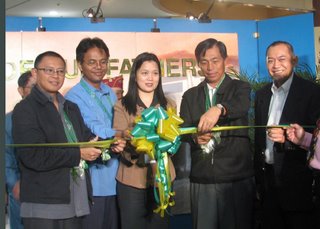


It was such an honor for us in the Veterans Bank to be part of the 65th Anniversary of the Lingayen Gulf Landing held last January 9. It was about sixty five years ago, that day, that the most massive naval & military landing in Luzon in World War II happened in
If you look at it closely, Lingayen gulf is a strategic site geographically for military landings if the target is to take the whole of
It’s interesting to note that Lingayen Gulf at the La Union side was the site of the Japanese invasion forces in
We were really excited when Gov. Amado Espino gave us the privilege accorded two years ago, to update and refurbish the
The new history panels, 12 in all, contain numerous photographs and maps about the Lingayen Landing and other World War II vintage photographs mostly featuring various locations in Pangasinan such as Dagupan, San Fabian and others.
Two of these panels feature the paintings on the Lingayen Landing done by a civilian artist commissioned by Abbott Laboratories to aid the war effort. These paintings are in the possession of the US Naval archives (I borrowed an image from their website above, but one can order a reproduction from them.) It features scenes from the historic landing and as the troops moved inland, including Lingayen airfield and the Binmaley church.
The most striking painting is entitled “Spirit of 1945” portraying the lone Filipino guerilla fighter who, upon the risk of his own life, tried to signal the landing forces by waving an American flag that the Japanese had retreated and to stop destructive bombing of the coastline areas. To this day, no one knows the identity of this lone Pangasinense.
This is also the basis of the diorama situated in one of the four pillars. Another pillar contains very thick documents of the plans for the Lingayen Landing done by MacArthur’s Generals, which includes very detailed plans of how the invasion would take place. We believe many of the information here were supplied by Pangasinan Guerrillas.
At the middle is the updated marker is the centerpiece of the project, signifying a nation’s tribute to the men & women who sacrificed their lives in the last World War. The gentle water flowing behind the glass marker gives the visitor a calming effect. While the Memorial portrays the horrors of war, it reminds us that we today must all work for peace. The project was completed last September in time for the 65th Lingayen Landing anniversary.
Overall, the project hopes to provide new insight into this historic event, and highlights not only the American effort but the Filipino veterans’ bravery as well.
While the Lingayen Landing is primarily an American effort, the Filipino guerrillas’ important role and bravery cannot be denied in this particular stage of the war. Much like their brothers from all over the country, our war veterans of Pangasinan showed the world that the Filipino is capable of great heroism.
Getting there is quite easy. The memorial is located at the back of the Pangasinan Provincial Capitol in Lingayen and is a stone’s throw away from the beach.










